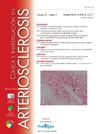Riesgo poligénico y aterosclerosis subclínica en individuos asintomáticos de mediana edad. Estudio ILERVAS
IF 1.9
Q3 PERIPHERAL VASCULAR DISEASE
引用次数: 0
Abstract
Introduction and objectives
More than 50% of first cardiovascular events (CVE) occur in populations identified as at low or intermediate risk by the risk equations, so the inclusion of additional variables, such as polygenic risk scores (PRS), has been proposed to improve the predictive capacity of these equations. The aim of this study was to assess whether a PRS, independently or with clinical risk equations, is associated with the presence, severity and extent of subclinical atherosclerosis.
Methods
109 subjects with atherosclerosis were selected from the ILERVAS cohort (primary prevention) and matched with 109 participants without atherosclerosis of the same age, sex and SCORE2 risk level. Atherosclerosis was assessed and quantified by arterial wall vascular ultrasound in 12 territories, and PRS was estimated using the Cardio inCode Score®. The predictive capacity of the presence of subclinical atherosclerosis was estimated, as well as the association between the extent and severity of atherosclerosis with PRS and clinical risk (SCORE2).
Results
PRS was similar between participants with or without atherosclerosis (P = 0.525). We did not find an association between PRS and SCORE2 (r = -0.29, P = 0.709), and the addition of PRS to SCORE2 did not improve the prediction of atherosclerosis [AUC (95% CI) = 0.566 (0.477, 0.654), P = 0.148]. The extent of atherosclerosis was related to SCORE2 (P = 0.009), but not to PRS (P = 0.709).
Conclusions
The Selected PRS is not associated with the presence of atherosclerosis or clinical risk, suggesting that its additional contribution to CVE risk would be mediated by mechanisms independent of the development of atherosclerosis. Additional biomarkers are needed to improve the prediction of subclinical atherosclerosis without using imaging tests as a first step in personalized assessment.
无症状中年人的多基因风险与亚临床动脉粥样硬化。ILERVAS研究。
简介和目标:超过50%的首次心血管事件(CVE)发生在风险方程确定为低或中等风险的人群中,因此已经提出纳入额外的变量,如多基因风险评分(PRS),以提高这些方程的预测能力。本研究的目的是评估PRS是否与亚临床动脉粥样硬化的存在、严重程度和程度相关,无论是独立的还是与临床风险方程相关。方法:从ILERVAS队列(一级预防)中选择109名动脉粥样硬化患者,与109名年龄、性别和SCORE2风险水平相同的无动脉粥样硬化患者配对。通过动脉壁血管超声对12个地区的动脉粥样硬化进行评估和量化,并使用Cardio inCode Score®评估PRS。评估亚临床动脉粥样硬化存在的预测能力,以及动脉粥样硬化的程度和严重程度与PRS和临床风险之间的关系(SCORE2)。结果:有无动脉粥样硬化的受试者的PRS相似(P=0.525)。我们没有发现PRS和SCORE2之间存在关联(r=-0.29, P=0.709),并且将PRS加入SCORE2并不能改善动脉粥样硬化的预测[AUC (95% CI)=0.566 (0.477, 0.654), P=0.148]。动脉粥样硬化程度与SCORE2相关(P=0.009),与PRS无关(P=0.709)。结论:选定的PRS与动脉粥样硬化或临床风险无关,表明其对CVE风险的额外贡献可能是由独立于动脉粥样硬化发展的机制介导的。需要额外的生物标志物来改善亚临床动脉粥样硬化的预测,而不是将影像学检查作为个性化评估的第一步。
本文章由计算机程序翻译,如有差异,请以英文原文为准。
求助全文
约1分钟内获得全文
求助全文
来源期刊

Clinica e Investigacion en Arteriosclerosis
PERIPHERAL VASCULAR DISEASE-
CiteScore
3.20
自引率
6.20%
发文量
44
审稿时长
40 days
期刊介绍:
La publicación idónea para acceder tanto a los últimos originales de investigación como a formación médica continuada sobre la arteriosclerosis y su etiología, epidemiología, fisiopatología, diagnóstico y tratamiento. Además, es la publicación oficial de la Sociedad Española de Arteriosclerosis.
 求助内容:
求助内容: 应助结果提醒方式:
应助结果提醒方式:


